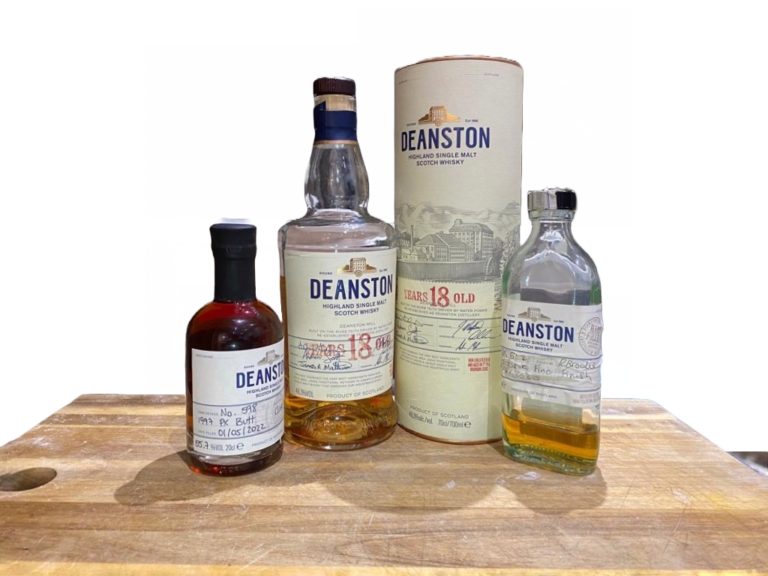26/12/2022
Chapter 3
Deanston: my first distillery tasting
Like the first kiss, you’ll always remember your first distillery tasting…actually I can’t recall my first kiss (ooops)
Just a stone throw away from Edinburgh and Glasgow
Three mind blowing drams - what a first distillery tasting!
Waiting for us was a very kind young host with a broken arm (sorry I’m crap with names and can’t recall yours)…and 3 mind blowing drams! One is still in my top-5-ever! Common denominator of these 3 drams: hand-filled single cask distillery exclusive. What do I mean with that? See side note – geeks already know this stuff.
Back to the drams: a Deanston 8 years-old matured entirely in bourbon casks, a Deanston 19 years-old finished in organic fino casks and a Deanston 17 years-old entirely matured in Amontillado Sherry casks. What a symphony! They were our first cask strength whiskies at 50%+ abv. We had to add some water, give them a bit of time while having a nice chat with our host. There were even few cask residues in the glass. I remember the viscosity and texture of the spirits, especially the older ones. Clinging to the sides of the glass and slowly dripping back down as they were honey.
Childhood memories

I won’t bother you with tasting notes as I’m not a professional and I know Leo is preparing his crusade against them…I like sharing the memories that the notes triggered. With the 19 YO Fino I remember my granny’s furniture, christmas gatherings around the fire, italian mulled wine (Vin brulé), panettone, croccante mordicchio…glimpses of lost childhood memories in a glass. I was astonished!
My precious treasure
We then moved to the shop and sampled some more. A Deanston 1991 muscat (if you don’t like artichoke – don’t try this), Deanston Union Fino and Deanston Union PX. It was so tempting to buy everything, but we concentrated on those we tried. I took a 20cl bottle of the Fino, peppino a 20cl of amontillado. I regretted not buying more! I came back in another occasion to buy a Deanston 25 years-old PX without even tasting it first. The fino is still in my top-5-drams-ever and I have probably a last dram or so left which I’d be happy to share with you. The PX is as well pure joy…xmas in a glass – a joy to share.
Do you want to have a distillery tasting experience without having to travel to Scotland?
Drams
and more...
Today's drams
- Deanston 18 – 46.3%
- Deanston 19 Fino – 55.3%
- Deanston 25 PX – 55.7%
Deanston Distillery
Thank you Deanston for hosting us. It was an amazingly warm welcome even during Covid. I came back twice after that day and it’s always a pleasure. Definitively worth the day trip from Edinburgh or Glasgow.
From the Cask to the Bottle
I was extremely surprised to learn what happens to whisky between the cask and the bottle.
For a bottle you find in supermarkets and travel retails for example:
- First many casks are emptied and mixed together (no issue with this marriage).
- Second, a filter removes any cask solid residues which might be unpleasant (again no issue).
- Then the nearly freeze the liquid and force it through a very special filter. A lot of the oils that would make the whisky cloudy if cold or if you add water below ca 45% are so removed. And with those oils a lot of taste and texture remains in that magic filter.
- Finally, water is added to dilute it to 43% or 40% (minimum legal to be called whisky).
- Often some caramel (E150) is added to guarantee consistent colour between batches (or to boost colour to make it more attractive on a shelf).
Now, referring back to Roy’s ABCD:
- No age statement whiskies (NAS) can be good as shared in my chapter 2;
- Whisky with little E150 can be really enjoyable and I guess most of us wouldn’t spot the difference;
- Some lower abv whiskies can be really nice experiences too especially as an opener and I’ve already shared some examples
But chill-filtering I don’t get it. I mean I do get it. You want to sell clear whisky at 40% in a fancy bottle for a lot of money. Fine. But even for process cost point of view and investment and labour who needs to follow the process…you are adding an unnecessary step.
Don’t get me wrong. As usual, be open minded. Try everything, filtered or not and make your own decisions. Personally, I appreciate those who give me the whole product as whisky is made in the cask. And I want it all. If possible with the cask residues.
Try some hand-filled cask strength products like these ones…and let me know!